
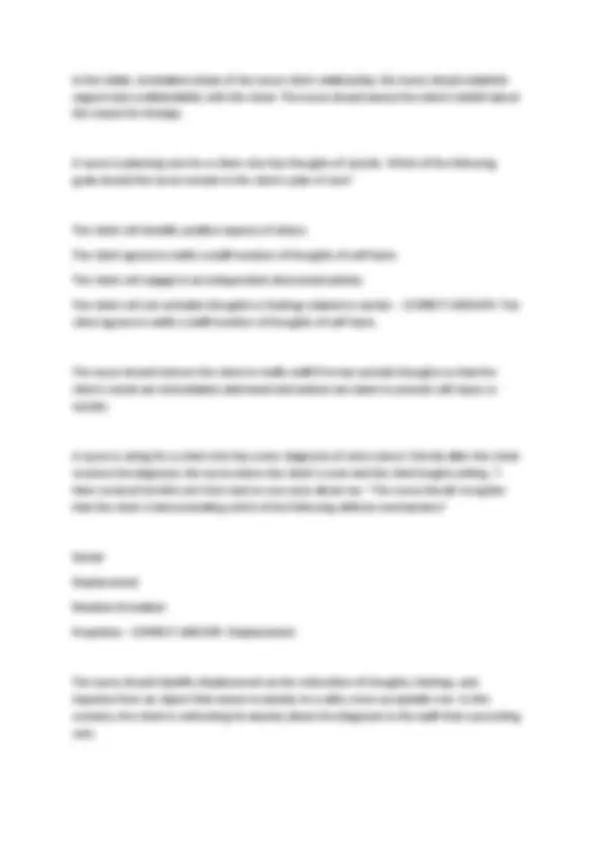
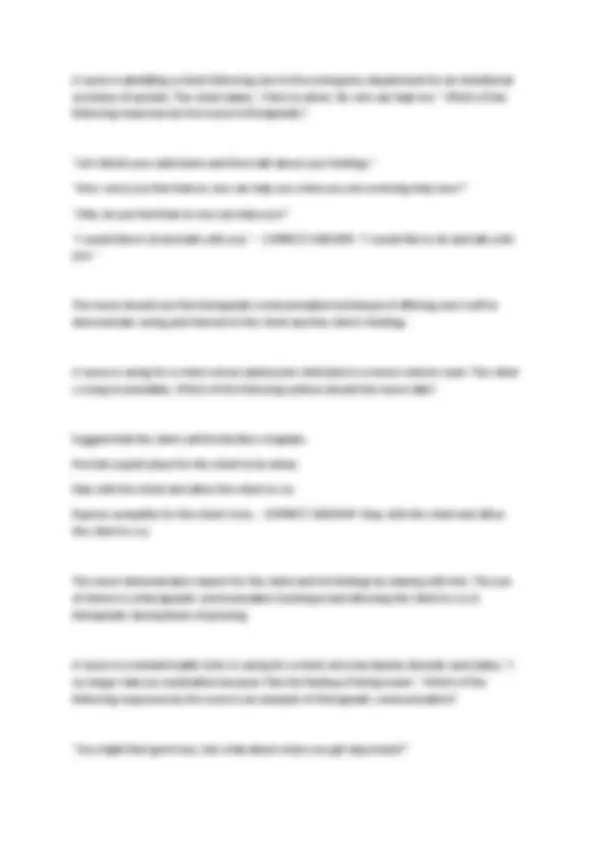
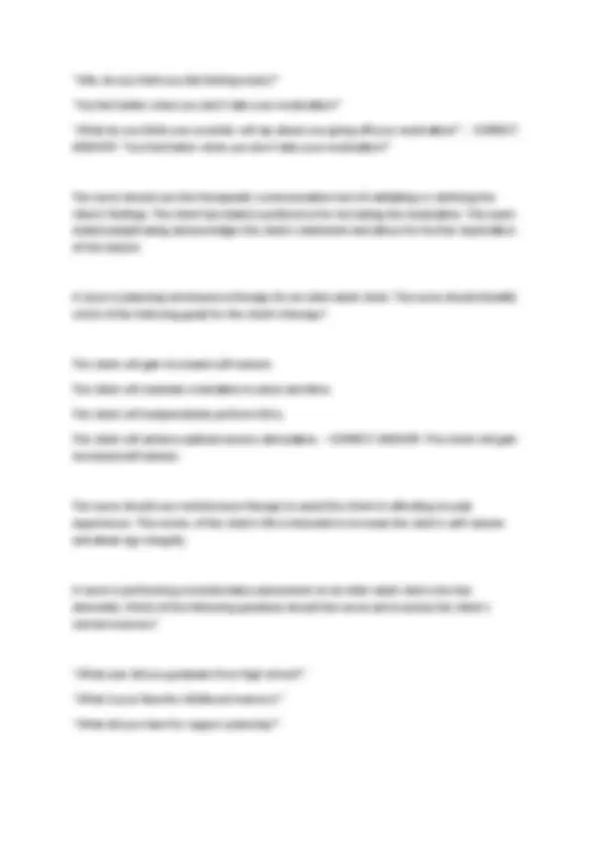
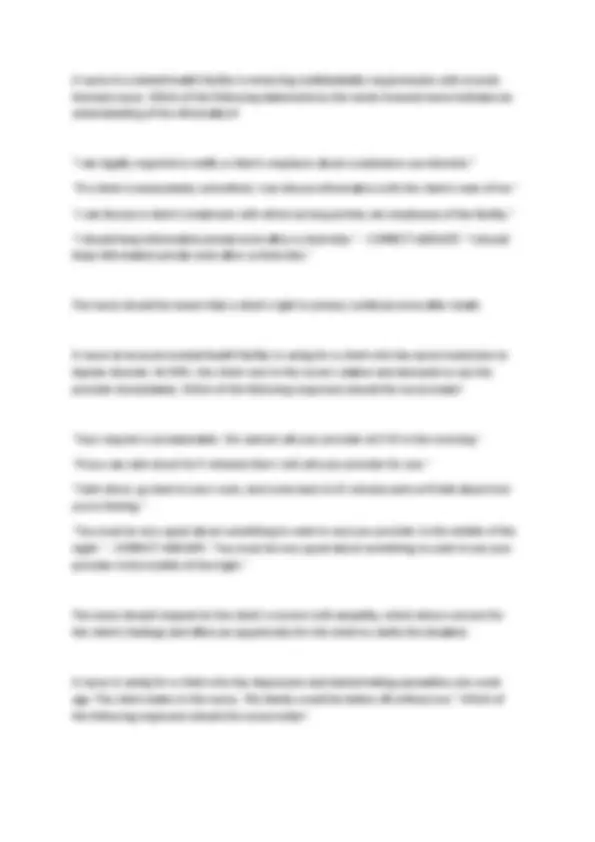
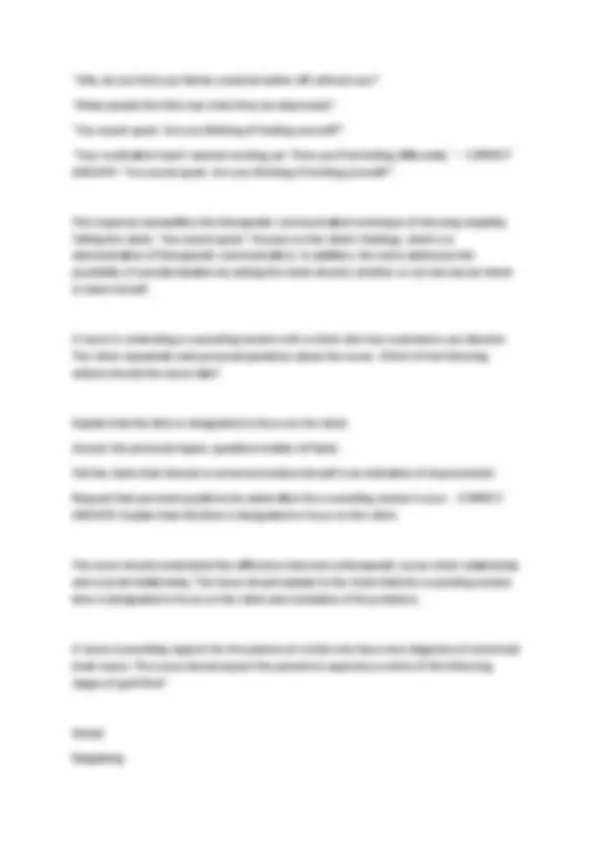
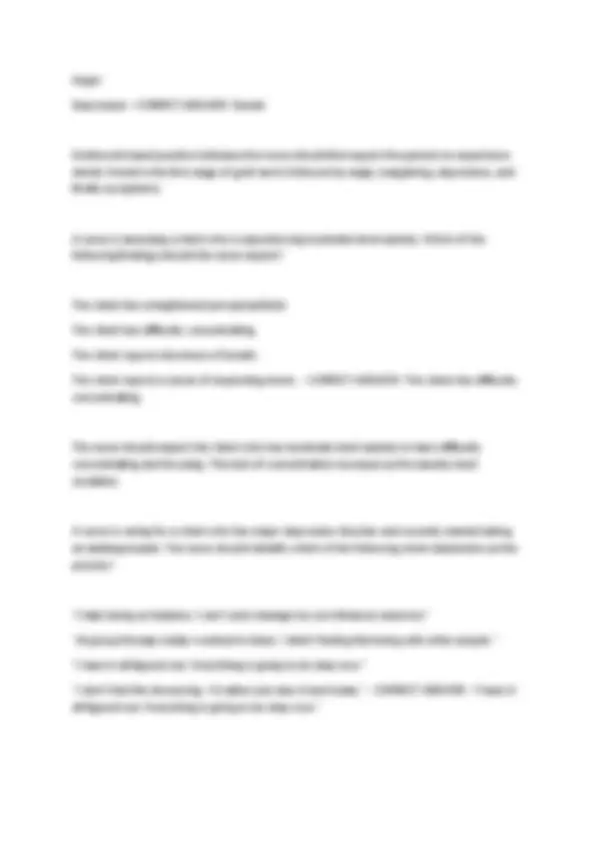
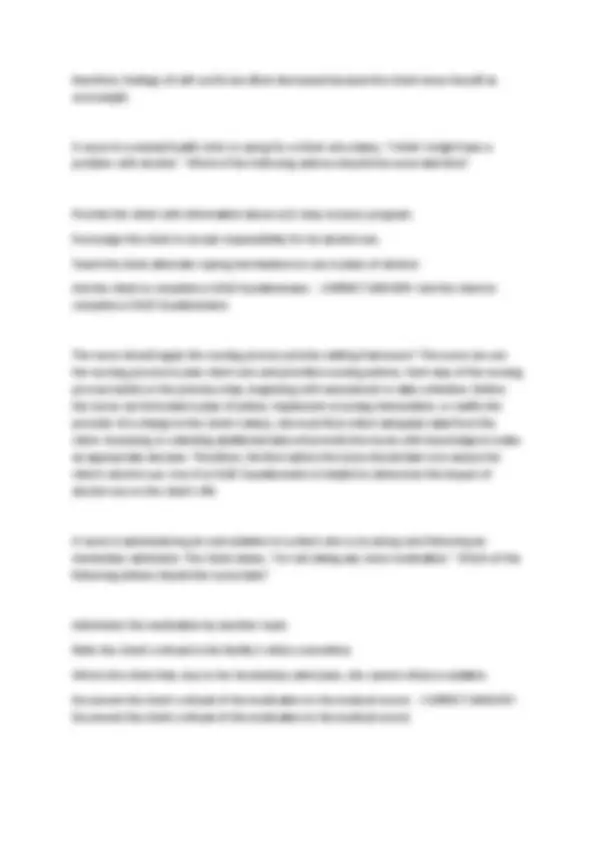



Study with the several resources on Docsity

Earn points by helping other students or get them with a premium plan


Prepare for your exams
Study with the several resources on Docsity

Earn points to download
Earn points by helping other students or get them with a premium plan
Community
Ask the community for help and clear up your study doubts
Discover the best universities in your country according to Docsity users
Free resources
Download our free guides on studying techniques, anxiety management strategies, and thesis advice from Docsity tutors
ATI RN LEARNING SYSTEM MENTAL HEALTH PRACTICE QUIZ 1 A nurse enters a client's room and observes that the client is agitated and pacing rapidly. The client looks at the nurse and says, "Back off. Leave me alone." Which of the following statements should the nurse make? "I demand that you calm down now. Your behavior is unacceptable." "I will close the door to provide privacy, and you can tell me what is bothering you." "I will give you space if you calm down. Tell me what is causing you to feel so tense." "I will leave you alone for a few minutes while you try to control yourself." - CORRECT ANSWER -"I will give you space if you calm down. Tell me what is causing you to feel so tense." The nurse should stay at a safe distance and remain calm while stressing the importance of maintaining control. The nurse should use verbal de-escalation techniques while determining the client's needs and respecting the client's personal space.
Typology: Exams
1 / 14

This page cannot be seen from the preview
Don't miss anything!









A nurse enters a client's room and observes that the client is agitated and pacing rapidly. The client looks at the nurse and says, "Back off. Leave me alone." Which of the following statements should the nurse make? "I demand that you calm down now. Your behavior is unacceptable." "I will close the door to provide privacy, and you can tell me what is bothering you." "I will give you space if you calm down. Tell me what is causing you to feel so tense." "I will leave you alone for a few minutes while you try to control yourself." - CORRECT ANSWER - "I will give you space if you calm down. Tell me what is causing you to feel so tense." The nurse should stay at a safe distance and remain calm while stressing the importance of maintaining control. The nurse should use verbal de-escalation techniques while determining the client's needs and respecting the client's personal space. A nurse is caring for a client who has borderline personality disorder. The nurse enters the client's room and finds the client cutting into his flesh with a paper clip. After providing first air, which of the following actions should the nurse take first? Encourage the client to discuss feelings about his self-injurious behavior during group therapy. Fill out an incident report for risk management about the client's self-injurious behavior. Document the client's self-injurious behavior in his medical record. Identify the client's feelings that led to the self-injurious behavior. - CORRECT ANSWER - Identify the client's feelings that led to the self-injurious behavior.
The nurse should apply the nursing process priority-setting framework. The nurse can use the nursing process to plan client care and prioritize nursing actions. Each step of the nursing process builds on the previous step, beginning with assessment or data collection. Before the nurse can formulate a plan of action, implement a nursing intervention, or notify the provider of a change in the client's status, she must first collect adequate data from the client. Assessing or collecting additional data will provide the nurse with knowledge to make an appropriate decision. Therefore, the first action the nurse should take is to assist the client to identify events or feelings that led to his self-injurious behavior. A nurse is caring for a client who reminds her of a negative person in her past. These memories cause the nurse to unconsciously displace negative feelings towards the client. The nurse should recognize that she is demonstrating which of the following? Suppression Countertransference Transference Assertiveness - CORRECT ANSWER - Countertransference The nurse demonstrates countertransference by unconsciously attributing feelings, positive or negative, about another towards the client. A nurse is establishing a therapeutic relationship with a client who has hallucinations. Which of the following actions should the nurse take during the orientation phase? Identify the client's perception of the reason for therapy. Ask the client to provide a detailed description of the hallucinations. Assist the client with the development of problem-solving skills. Explore the client's relationship with family members. - CORRECT ANSWER - Identify the client's perception of the reason for therapy.
A nurse is admitting a client following care in the emergency department for an intentional overdose of opioids. The client states, "I feel so alone. No one can help me." Which of the following responses by the nurse is therapeutic? "Let's finish your admission and then talk about your feelings." "How come you feel that no one can help you when you are receiving help now?" "Why do you feel that no one can help you?" "I would like to sit and talk with you." - CORRECT ANSWER - "I would like to sit and talk with you." The nurse should use the therapeutic communication technique of offering one's self to demonstrate caring and interest in the client and the client's feelings. A nurse is caring for a client whose adolescent child died in a motor-vehicle crash. The client i crying inconsolably. Which of the following actions should the nurse take? Suggest that the client call the facility's chaplain. Provide a quiet place for the client to be alone. Stay with the client and allow the client to cry. Express sympathy for the client's loss. - CORRECT ANSWER - Stay with the client and allow the client to cry. The nurse demonstrates respect for the client and his feelings by staying with him. The use of silence is a therapeutic communication technique and allowing the client to cry is therapeutic during times of grieving. A nurse in a mental health clinic is caring for a client who has bipolar disorder and states, "I no longer take my medication because I like the feeling of being manic." Which of the following responses by the nurse is an example of therapeutic communication? "You might feel good now, but what about when you get depressed?"
"Why do you think you like feeling manic?" "You feel better when you don't take your medication?" "What do you think your provider will say about you going off your medication?" - CORRECT ANSWER - "You feel better when you don't take your medication?" The nurse should use the therapeutic communication tool of validating or clarifying the client's feelings. The client has stated a preference for not taking the medication. This open- ended paraphrasing acknowledges the client's statement and allows for further exploration of the subject. A nurse is planning reminiscence therapy for an older adult client. The nurse should identify which of the following goals for the client's therapy? The client will gain increased self-esteem. The client will maintain orientation to place and time. The client will independently perform ADLs. The client will achieve optimal sensory stimulation. - CORRECT ANSWER - The client will gain increased self-esteem. The nurse should use reminiscence therapy to assist the client in reflecting on past experiences. This review of the client's life is intended to increase the client's self-esteem and attain ego integrity. A nurse is performing a mental status assessment on an older adult client who has dementia. Which of the following questions should the nurse ask to assess the client's remote memory? "What year did you graduate from high school?" "What is your favorite childhood memory?" "What did you have for supper yesterday?"
The nurse should use the therapeutic communication technique of restating when responding to the feelings the client has expressed. Restating focuses on the main idea of the client's statement and helps the client understand and explore personal behaviors. A nurse is caring for a client at a college mental health counseling center. The client receives a failing grade in a course and spends the entire counseling session blaming the teacher. The nurse should recognize this behavior as an example of which of the following defense mechanisms? Projection Dissociation Undoing Compensation - CORRECT ANSWER - Projection The nurse should identify that a client is using projection when unconsciously transferring unacceptable feelings, thoughts, or traits in oneself onto another person. This response is maladaptive because it prevents the client from accepting responsibility for personal performance in school. A nurse in an emergency department is caring for an 18-month old toddler who has a fractured left femur. Which of the following statements by the toddler's parents should cause the nurse to suspect child abuse? "My child fell down the stairs." "My child was riding a bicycle and fell off." "My child slipped out of the high chair." "My child climbed up on a chair and it tipped over." - CORRECT ANSWER - "My child was riding a bicycle and fell off." The nurse should suspect possible child abuse in response to this statement because an 18- month-old toddler is not expected to have the developmental ability to ride a bicycle.
A nurse in a mental health facility is reviewing confidentiality requirements with a newly licensed nurse. Which of the following statements by the newly licensed nurse indicates an understanding of the information? "I am legally required to notify a client's employer about a substance use disorder." "If a client is involuntarily committed, I can discuss information with the client's next of kin." "I can discuss a client's treatment with others as long as they are employees of the facility." "I should keep information private even after a client dies." - CORRECT ANSWER - "I should keep information private even after a client dies." The nurse should be aware that a client's right to privacy continues even after death. A nurse at an acute mental health facility is caring for a client who has acute mania due to bipolar disorder. At 0300, the client runs to the nurse's station and demands to see the provider immediately. Which of the following responses should the nurse make? "Your request is unreasonable. We cannot call your provider at 3:00 in the morning." "If you can calm down for 5 minutes then I will call your provider for you." "Calm down, go back to your room, and come back in 15 minutes and we'll talk about how you're feeling." "You must be very upset about something to want to see your provider in the middle of the night." - CORRECT ANSWER - "You must be very upset about something to want to see your provider in the middle of the night." The nurse should respond to the client's concern with empathy, which shows concern for the client's feelings and offers an opportunity for the client to clarify the situation. A nurse is caring for a client who has depression and started taking paroxetine one week ago. The client states to the nurse, "My family would be better off without me." Which of the following responses should the nurse make?
Anger Depression - CORRECT ANSWER - Denial Evidenced-based practice indicates the nurse should first expect the parents to experience denial. Denial is the first stage of grief and is followed by anger, bargaining, depression, and finally acceptance. A nurse is assessing a client who is experiencing moderate level anxiety. Which of the following findings should the nurse expect? The client has a heightened perceptual field. The client has difficulty concentrating. The client reports shortness of breath. The client reports a sense of impending doom. - CORRECT ANSWER - The client has difficulty concentrating. The nurse should expect the client who has moderate-level anxiety to have difficulty concentrating and focusing. This lack of concentration increases as the anxiety level escalates. A nurse is caring for a client who has major depressive disorder and recently started taking an antidepressant. The nurse should identify which of the following client statements as the priority? "I hate being so helpless. I can't even manage my own finances anymore." "At group therapy today I wanted to leave. I didn't feeling like being with other people." "I have it all figured out. Everything is going to be okay now." "I don't feel like showering. I'd rather just stay in bed today." - CORRECT ANSWER - "I have it all figured out. Everything is going to be okay now."
The nurse should apply the safety and risk reduction priority-setting framework. This framework assigns priority to the factor or situation posing the greatest safety risk to the client. When there are several risks to client safety, the one posing the greatest threat is the highest priority. The nurse should use Maslow's hierarchy of needs, the ABC priority-setting framework, or nursing knowledge to identify which risk poses the greatest threat to the client. Therefore, the nurse should identify that this client statement is the priority because it indicates a possible plan for suicide. This reaction is possible after starting an antidepressant, when the client gains the energy to act upon suicidal thoughts. A nurse is caring for a client who is brought in the clinic by her adult son who states that his father recently died. The client repeatedly yells at her son stating, "Quit lying about your father!" The nurse should recognize that the client is demonstrating which of the following defense mechanisms> Denial Identification Introjection Sublimation - CORRECT ANSWER - Denial The nurse should recognize that the client is demonstrating denial through her belief that her son is lying about her partner's death. A nurse is caring for a client who has alcohol use disorder and is recieving treatment for alcohol withdrawl. The client reports hand tremors 12 hours after admission. Which of the following statements should the nurse make? "The tremors are permanent due to nerve damage caused by chronic alcohol use." "The tremors will persist for a few days as you are withdrawing from alcohol." "Try not to worry about the tremors. Everyone has these during alcohol withdrawal." "These tremors are an indication of seizures that are associated with alcohol withdrawal." - CORRECT ANSWER - "The tremors will persist for a few days as you are withdrawing from alcohol."
therefore, feelings of self-worth are often decreased because the client views herself as overweight. A nurse in a mental health clinic is caring for a client who states, "I think I might have a problem with alcohol." Which of the following actions should the nurse take first? Provide the client with information about a 12-step recovery program. Encourage the client to accept responsibility for his alcohol use. Teach the client alternate coping mechanisms to use in place of alcohol. Ask the client to complete a CAGE Questionnaire. - CORRECT ANSWER - Ask the client to complete a CAGE Questionnaire. The nurse should apply the nursing process priority-setting framework. The nurse can use the nursing process to plan client care and prioritize nursing actions. Each step of the nursing process builds on the previous step, beginning with assessment or data collection. Before the nurse can formulate a plan of action, implement a nursing intervention, or notify the provider of a change in the client's status, she must first collect adequate data from the client. Assessing or collecting additional data will provide the nurse with knowledge to make an appropriate decision. Therefore, the first action the nurse should take is to assess the client's alcohol use. Use of a CAGE Questionnaire is helpful to determine the impact of alcohol use on the client's life. A nurse is administering an oral sedetive to a client who is receiving care following an involuntary admission. The client states, "I'm not taking any more medication." Which of the following actions should the nurse take? Administer the medication by another route. Refer the client's refusal to the facility's ethics committee. Inform the client that, due to her involuntary admission, she cannot refuse a sedative. Document the client's refusal of the medication in the medical record. - CORRECT ANSWER - Document the client's refusal of the medication in the medical record.
The nurse should respect the client's right to refuse medication, even if the client is receiving treatment due to an involuntary admission. The nurse should document this refusal in the medical record and assess the reasons for the client's refusal.